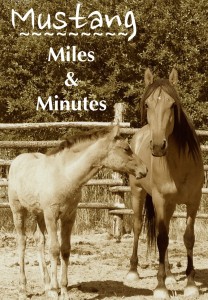 Welcome Mustang Miles & Minutes, a new BestHorsePractices feature about a personal horsemanship journey with Raechel Nelson and two wild horses she adopted from the Bureau of Land Management’s Wild Horse and Burro program.
Welcome Mustang Miles & Minutes, a new BestHorsePractices feature about a personal horsemanship journey with Raechel Nelson and two wild horses she adopted from the Bureau of Land Management’s Wild Horse and Burro program.
The Miles & Minutes purpose is to help highlight the dire need for more responsible adopters for BLM horses and burros as well as the incredible challenges of doing right by these animals as their world turns upside down and becomes one of domestication.
Miles & Minutes is generously sponsored by Redmond Equine.
Check out our extensive mustang library.
Raechel’s journey, you’ll discover, is one of miles and minutes. They are filled with tiny, split-second decisions as well as long stretches of what non-horse folks might call boredom.
As you know, progress comes in many shapes and sizes. And, yes, what you consider progress one day, might come back the next day to reveal itself as, in fact, regression.
The journey for Nelson started a while back, when she began researching BLM horses. The 30-year old grew up on a Colorado ranch, has started horses, and worked with cows. She knows a lot. But she’s never worked with a mustang.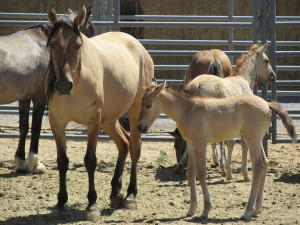
When the BLM announced it would be selling mare/foal pairs, she merged two paths of thought – I want a challenge and I would love for at least one pair to not have to suffer the long cross country trek to a faraway adopter or to languish at the holding facility.
She scrutinized the many mare/foal pairs that the BLM posted on line, considering their confirmation, height, and age. In May, with truck and trailer and a BLM-approved pen ready and waiting, we headed south to Delta, where the agency has its only Utah facility.
There were a few hundred horses and burros there. Some were older and will likely never be adopted, instead being shipped to long-term holding facilities. Some were yearlings. According to many, these young ones have the best success as d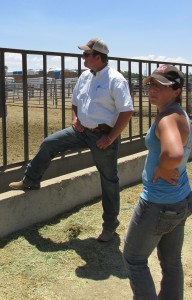 omesticated animals.
omesticated animals.
Nelson focused on the mare/foal pairs, of which there were about 10. She watched them move and interact. We chatted about their build and behaviors. After a few hours, she made her decision. It would be a four-year old dun with tag 5469 and her six-week old filly.
Facility manager and horseman Carey McClellan visited with Nelson about her choice and weighed in with his two cents, based on years of experience and specific observations of this particular mare. He confirmed it as a good choice.
The task to separate them from their paddock mates began by McClellan entering the 100’ x 100’ paddock and quietly tapping on the side of their shelter. The horses immediately stampeded out of the paddock towards a system of alleyways and enclosures. I was amazed by how sensitive they were to his slightest movements and appreciated how deftly he worked.
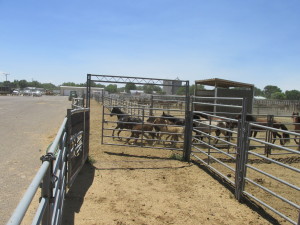 The sorting process wasn’t pretty. Especially if you’d never seen wild animals in tight quarters. We forget how wild they are when looking at pictures and watching them hang out in pens.
The sorting process wasn’t pretty. Especially if you’d never seen wild animals in tight quarters. We forget how wild they are when looking at pictures and watching them hang out in pens.
Through a system of narrow, curving passages, based on a design developed by Temple Grandin, McClellan singled out first the mare and placed her in an isolated pen.
Her filly had ended up at the back of the herd in the scramble down the alleyways. McClellan sorted the others, placed the filly in the hydraulic squeeze chute to cut off her neck ID rope, then released her to her mother.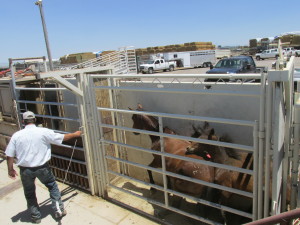
Next, I backed the trailer to a secure opening, making sure there were no possible escape routes. We opened paddock gates and trailer doors. With a quiet gesture from McClellan, the mare sniffed the trailer, then bounded in with her baby.
We rushed to closed the back door, then moved them forward and closed the pair in front of the trailer’s center wall. (This strategy would prove essential to our safe unloading a few hours later.)
After several restless minutes, the mare and foal settled in for the two and a half hour drive home. Once there, I backed the trailer directly into the enclosure. Thankfully, the width of the trailer was about the same as the width of the round pen gate, making it safe and secure for their release.
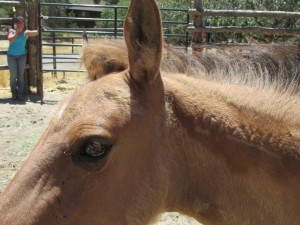 We opened the back of the trailer, then attached a rope to the center wall so that we could avoid being in harm’s way as it was opened. Raechel pulled it open and, after a moment’s hesitation, Mom and Baby rushed off the trailer and to the far side of the pen.
We opened the back of the trailer, then attached a rope to the center wall so that we could avoid being in harm’s way as it was opened. Raechel pulled it open and, after a moment’s hesitation, Mom and Baby rushed off the trailer and to the far side of the pen.
The safe and relieving end to a super-charged day! We gave a quiet cheer and watched them watch us. The mare looked around some more, snorted, and started grazing a few bits of grass.
Coming next:
Getting to work
First memorable moments
Getting hands on. Or not.
Miles & Minutes is generously sponsored by Redmond Equine.
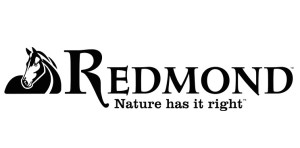
Thanks Rachael for extending your humanity to Miles and Minutes. If viewers read between the lines, the true story surfaces. Horses that have been removed from their natural environment have lost their soul. The holding facilities amount to no more than prisons for mustangs. Hopefully as more viewers witness this 5 minute video, they will be encouraged TO ADOPT and help save a horse (s) soul. I ‘ve been building a relationship (parnership) with my adopted mustnag over the course of the past 5 years.
Thanks, John. Very well said.